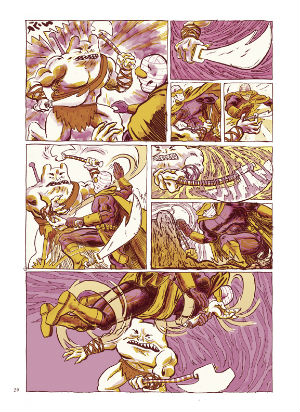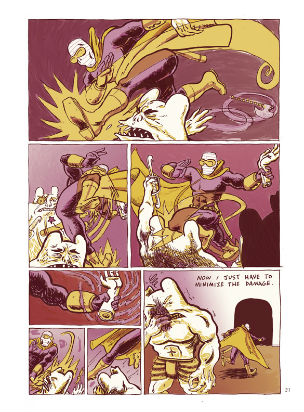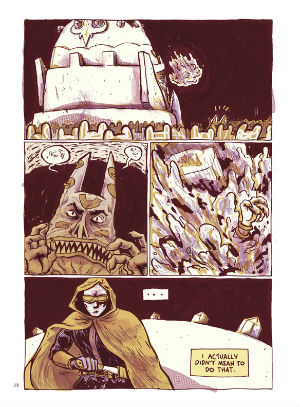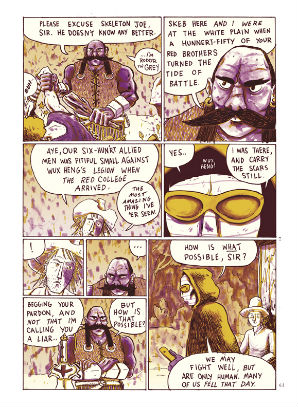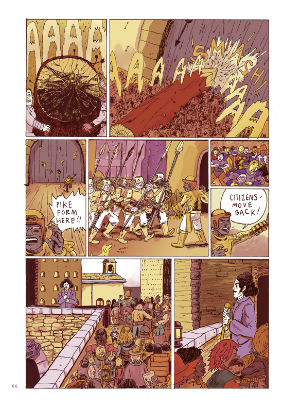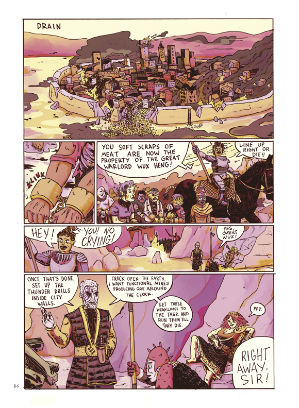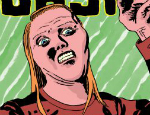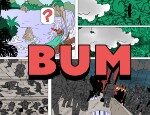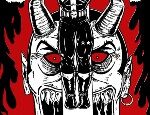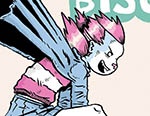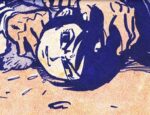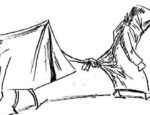As far back as the ’70s, small press comics have always included works from the fantasy genre, with the art comics scene of the last 20 years frequently using futuristic or fantastical setting as a means to discuss contemporary issues. What has been more rare as of late is a purely fantasy adventure comic rendered in an indie comics aesthetic. Zack Soto’s The Secret Voice Vol. 1 is a book that melds the flourish and electricity of avant-garde comics with the imagination and complex world-building of genre fantasy. Soto confidently draws the reader into an unknown world without ever having it feel trite or by the numbers, thus conjuring a universe that can both excite younger readers with its magic and mystery while remaining lived-in and grounded enough to fully engage savvier readers.
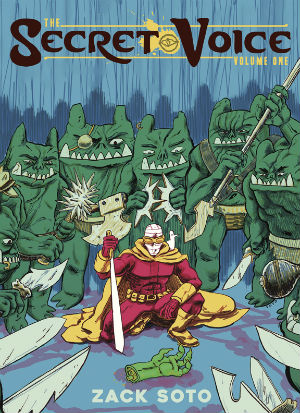 The story begins with its principal players already moving across the board and the battle for the known world well underway. Soto inductively brings the reader into The Troll Kingdom by letting his camera slowly travel through its caves, rickety walkways, and water relays until finally settling on the Troll King’s throne room and our hero Doctor Galapagos. We find Galapagos mid-conversation with the Troll King, warning him of the looming threat of The Smog Emperor Wux Heng. These early choices to show the reader the world and its characters without exposition, while setting the stakes of the conflict so directly, are indicative of the confidence Soto has in his readers to invest in the action even without grasping the larger fiction. Doctor Galapagos himself is not named until deep into this first volume yet his sinewy body clad in purple with face wrapped in gauze and strange yellow glasses suggests an entire history that only further intrigues the reader. In delaying the reveal of so many of the details of the world our curiosity is piqued pulling us further into the world Soto is building.
The story begins with its principal players already moving across the board and the battle for the known world well underway. Soto inductively brings the reader into The Troll Kingdom by letting his camera slowly travel through its caves, rickety walkways, and water relays until finally settling on the Troll King’s throne room and our hero Doctor Galapagos. We find Galapagos mid-conversation with the Troll King, warning him of the looming threat of The Smog Emperor Wux Heng. These early choices to show the reader the world and its characters without exposition, while setting the stakes of the conflict so directly, are indicative of the confidence Soto has in his readers to invest in the action even without grasping the larger fiction. Doctor Galapagos himself is not named until deep into this first volume yet his sinewy body clad in purple with face wrapped in gauze and strange yellow glasses suggests an entire history that only further intrigues the reader. In delaying the reveal of so many of the details of the world our curiosity is piqued pulling us further into the world Soto is building.
Another element of Soto’s confident visual story telling occurs when we see Doctor Galapagos in action cutting his way through trolls and spit golems. Soto is highly adept at drawing the action and movement of Galapagos leaping and tumbling through underground caves while dodging the spears and swords of his pursuers. Were it not for its muted pastel color palette the sequence’s pacing, composition within panels, and renderings of bodies in motion could easily pass for one of the better superhero comic from the ’70s. Galapagos’ movements through space are also so kinetic and weighty that when he reaches safety and collapses the reader can feel his exhaustion. The mysterious and magical figure now humbled by extending himself to his limits. The introduction of his travelling companions Dalitt the talking seagull and the peasant boy Petir both further humanizing Galapagos and again hinting at the complex backstory of our masked hero.
The Secret Voice is far more interested in inhabiting its lore than explaining it. Ghost and forest spirits are encountered from Galapagos’ well-traveled viewpoint with no audience surrogate asking questions about them. In another bold choice Soto cuts to The Smog Emperor’s siege on the city of Drain and Proctor General Absalom of the Red College marshaling the city’s forces right as the battle is about to reach its apex. The Emperor’s full war machine never seen, but the grey creep that has ravaged Doctor Galapagos’ face after a battle with those forces letting the reader surmise its destructive power. This decision to let the reader piece together the cosmology of the world further exemplified by the Red College Arcana stories Doctor Xim and Wrongness Beyond and Pathway to the Gate, Entry to the Door presented at the end of the volume. Much like the highwaymen who make way for Galapagos out of reverence to his station, we need only see members of the Red College’s racially and gender diverse cast of scholars at work to understand their power even if we do not fully understand its source. Similarly, a brief scene between Wux Heng and the witch Mysteria after the siege of Drain develops their personalities far more than their motivations, yet the reader comes away assured of the threat they pose.
Soto’s purposeful indifference to giving expositional information on the story’s larger arc is also reflected in his focus on Doctor Galapagos. He is neither the chosen hero, nor the most powerful member of the Red College, but the reader invests in Galapagos because of the struggles he faces both internally and externally. Throughout the book we see Galapagos try to cope with the debilitating effects that the grey creep is having on his physical and mental abilities. While he tries to hide this from his compatriots, they know that just like his bandaged body his encounter with Wux Heng’s forces have fundamentally changed him. This climaxes in an emotion scene where Galapagos returns to the Red College and reconnects with his wife Octavia, hesitantly revealing his deformity to her. As this is the first time the reader sees his ravaged face they may be taken aback by the way the grey creep has warped his visage, yet Octavia sees through to the man beneath. A man whom we see return to the high of his powers when the Red College must come together to repel an invasion by one of Wux Heng’s fungal colossi in another stunning action set piece.
The fantastical world of The Secret Voice is further brought to life by the unique way that Soto colors it. Instantly noticeable in the early portion of the book is Soto’s use of a contrasting purple and yellow palette that not only casts Doctor Galapagos as an atypical hero, but does much to make as well worn a fantasy landscape as underground troll caves feel distinct. Soto later introduces a shade of magenta that better separates out objects within the frame as well as adding a greater texture of lighting. Though only in the conclusion do we see a tiny patch of green on the face of a mysterious agent and few splashes of otherworldly blue that highlight the biological horror of the fungal colossi. This decision to eschew the earthier tones typical of medial fantasy makes Soto’s world feel wholly its own rather than borrowed piecemeal from other works.
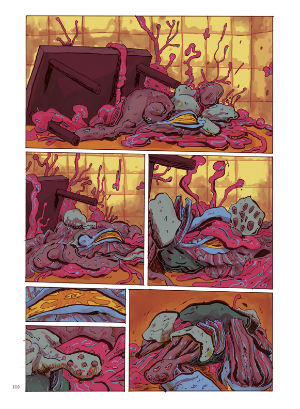 The other unique element Soto brings to The Secret Voice is his visual mix of pulpy action comics and art comics. His panels are just as often densely packed with movement as they are with detail. Actions happening in rapid-fire small panels while silent vistas are given half a page to breath; Soto taking no shortcuts when it comes to drawing out the clash of massive armies or the intricate curved architecture of a Red College temple. When he draws physical and magical conflict it feels believable and consequential. Yet the way his crisp line work on the characters contrasts with the frantic scribbled nature of the colored cross-hatching on their bodies imbues them with a strange energy befitting the magical proceedings. At times Soto goes so far as to compose elements within the composition entirely out of thick crayon like lines that recall mid-2000s art brut comics, but rather than abstract the image they give life to the metaphysical portions of Galapagos’ quest. As with his other artistic choices, by taking the lush way that fantasy genre comics are frequently drawn and giving it an idiosyncratic spin Soto showcases a stunning synchronicity of craft and vision.
The other unique element Soto brings to The Secret Voice is his visual mix of pulpy action comics and art comics. His panels are just as often densely packed with movement as they are with detail. Actions happening in rapid-fire small panels while silent vistas are given half a page to breath; Soto taking no shortcuts when it comes to drawing out the clash of massive armies or the intricate curved architecture of a Red College temple. When he draws physical and magical conflict it feels believable and consequential. Yet the way his crisp line work on the characters contrasts with the frantic scribbled nature of the colored cross-hatching on their bodies imbues them with a strange energy befitting the magical proceedings. At times Soto goes so far as to compose elements within the composition entirely out of thick crayon like lines that recall mid-2000s art brut comics, but rather than abstract the image they give life to the metaphysical portions of Galapagos’ quest. As with his other artistic choices, by taking the lush way that fantasy genre comics are frequently drawn and giving it an idiosyncratic spin Soto showcases a stunning synchronicity of craft and vision.
Though it may have taken years for Soto to complete this first volume of The Secret Voice it is a book that still feels fresh. Soto has created characters the reader can invest in and a world that our curiosity aches to explore more of. You can delve deep into piecing together the complex lore of this mysterious world while still feeling the very immediate stakes for its characters. The reader can just as easily get lost in the imaginative otherworldly sights brought to life though Soto’s unique mash-up of aesthetics. Hopefully, we will get to return to the adventures of Doctor Galapagos and the other members of the Red College sooner rather than later. There is so much left to see in the known world.
Zack Soto (W/A) • Floating World Comics, $24.95 (Advance review – released April 2019)
Review by Robin Enrico





